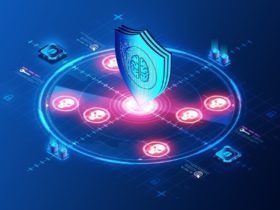In 2022, security data technologies will be more advance than ever before. This guide will explore the top security data technologies used in the future and how they can benefit businesses and organizations.
The world of security data is constantly changing and evolving. New technologies are being developed and implemented to keep up with the ever-changing landscape. As such, it can be difficult to stay up-to-date with all of the latest security data technologies.
That’s why we’ve put together this guide – to help you understand the top security data technologies. We’ll explore the benefits of each technology and how they can help you protect your business or organization.

Top Security Data Technologies
So, without further delay, let’s take a look at the top security data technologies for 2022:
Artificial Intelligence (AI)
One of the most popular security data technologies, Artificial intelligence (AI) will play an increasingly important role in cybersecurity in the coming years. AI can be used to detect and respond to threats automatically, as well as to help humans analyze and understand huge amounts of data.
In the next few years, we will see more AI-powered security products and services on the market. Here are some of the top AI data technologies to keep an eye on in 2022:
1. Threat detection and response: AI can automatically detect and respond to threats. This includes identifying malicious activity, such as malware, and blocking it before it can do any damage.
2. Security analytics: Analytics tools can help you make sense of all the data that your security system collects. This data can be used to identify trends and patterns, which can help you better understand the threats you face and how to protect against them.
3. User behavior analytics: This type of AI analyzes user behavior to detect anomalies that could indicate a security threat. For example, if someone is accessing sensitive data that they normally wouldn’t, this could be a sign that they’re up for something malicious.
4. Intrusion detection and prevention: AI can detect and prevent intrusions, such as attacks on your network or systems. This includes identifying unusual activity and blocking it before it can do any damage.
5. Identity and access management: AI can help manage users’ identities and access to data and systems. This includes ensuring that only the people who have access to sensitive information do and that they don’t have more access than they need.
More: 5 Best Practices For Patch Management in 2022
Big Data
Big data is another security data technology that has been gaining much attention in recent years. And for a good reason – big data can help organizations solve complex security problems.
Big data is a term which describe data sets that are too large and complex to be analyze using traditional methods.

Traditional methods of analysis include things like Excel spreadsheets and SQL databases. These methods are no longer effective when dealing with big data sets because they can’t handle the volume of data. Big data sets are usually structured, unstructured, and semi-structured data.
- Structured data is data that’s organize in a predefine way, like in a database.
- Unstructured data doesn’t have a predefined structure, like video or audio files.
- Semi-structured data is a mix of structured and unstructured data, like emails or social media posts.
The main challenge with big data is that it’s difficult to store, manage, and analyze. This is because traditional storage and analysis methods can’t handle the volume of data.
More: A Complete Guide On Cryptocurrency Security Best Practices
Cloud Security
Cloud security has become a top priority for businesses of all sizes recently. The trend is only expected to continue in the coming years as more and more businesses move their data and applications to the cloud.
As cloud adoption continues to grow, so does the need for effective security solutions to protect data and applications in the cloud.
Here are some of the top Cloud security technologies that businesses should be aware of:
Cloud Access Security Brokers (CASBs): A CASB is a cloud security solution that sits between an organization’s on-premises IT infrastructure and its cloud applications. It acts as a gateway, providing visibility and control over the data and traffic flowing between the two environments.
CASBs can help organizations secure their data in the cloud by providing data encryption, user activity monitoring, and threat detection.
Data Loss Prevention (DLP) Solutions: DLP solutions are designed to help organizations prevent sensitive data from being lost or leaked. They do this by identifying and classifying sensitive data and monitoring and blocking attempts to copy, move, or delete it.
DLP solutions can be deployed as on-premises software or as a cloud service. Cloud-based DLP solutions can provide more comprehensive protection, as they can monitor data in transit and at rest.
Final Thoughts
Security data technologies are constantly evolving, and it can be difficult to keep up with the latest trends. By familiarizing yourself with the most common security data technologies, you’ll be better equipped to decide which solutions are right for your organization.











